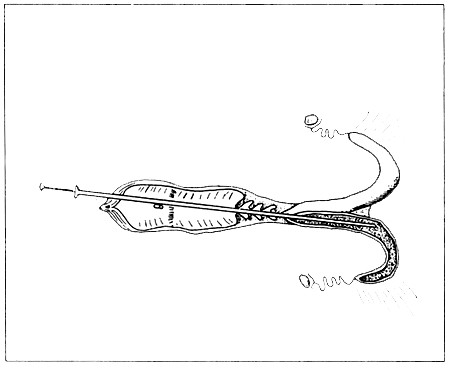It is common practice to treat the donor with prostaglandins after the collection of ova. The ovaries are generally greatly enlarged by the excessive number of corpora lutea. Such treatment will not only rapidly reduce the size of the ovaries, but also terminate any unwanted pregnancies should an occasional embryo not have been flushed out. As most embryo collections in buffaloes are done on days 5 and 6 when the CLs may not be fully mature, and hence responsive to prostaglandins, it is advisable to delay prostaglandin treatment for two to four days. It is best not to breed the donor on this induced heat three to five days later. Furthermore, like a spontaneous heat, the induced heat will have a salutary effect on uterine health should any contamination have been introduced at the time of the collection.
FIGURE 11
Location of the tip of the transfer syringe in the ipsilateral uterine horn at
the time of embryo deposition

Buffaloes can probably be superovulated at intervals of two months for three treatments without any appreciable decrease in response. Single embryo collections may be made when the animals come into oestrus and are inseminated between these superovulatory treatments.
Pregnant recipients should basically be managed like other pregnant buffaloes. Overly fat recipients are undesirable. When the recipients have reached day 21 to day 24 of their cycle (16–19 days after transfer on day 5), a presumptive diagnosis of pregnancy can be made based on palpation of the active corpus luteum, or indirectly by determining an elevated concentration of progesterone in the milk or plasma. Definitive pregnancy examinations are made at six weeks and confirmed at three months by palpation per rectum.